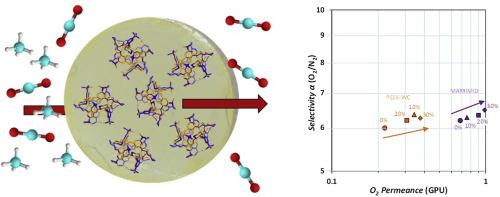Metal-organic cages in polyimide and polyetheretherketone thin film composite mixed matrix membranes for gas separation
IF 8.4
1区 工程技术
Q1 ENGINEERING, CHEMICAL
引用次数: 0
Abstract
Membrane-based gas separation has been recognized as one of the most promising and energy-efficient processes for CO2 capture from industrial gas streams. Remarkably, commercial gas separation membranes typically contain conventional polymers with sub-optimal performance, necessitating the search for better-performing materials. In this work, we developed novel mixed matrix membranes (MMMs) based on the benchmark polyimide Matrimid® 9725 and a soluble poly (ether ether ketone) PEEK-WC. The addition of a zinc-based metal-organic cage (MOC) featuring two calixsalen macrocyclic units significantly improved the transport properties for various gas pairs with an up to 100 % increase in permeability and up to 10 % increase in selectivity at 30 % MOC. SEM and DSC analyses offered valuable insights into the compatibility between the polymer and MOC, revealing excellent dispersion of up to 30 % of MOC with almost complete phase separation from the matrix. The thermal properties and transport properties were successfully described using the Fox equation and the Maxwell model, respectively. Most interestingly, thin film composites (TFCs) performed much better at 3 times higher cage concentrations than the corresponding self-standing thick films because the faster solvent evaporation limited crystal growth to sub-micron size, favouring a fine homogeneous distribution of the MOC in the polymer matrix. Based on their pure and mixed gas permeation, the TFC-MMMs show promise for the future development of new-generation gas separation membranes.

聚酰亚胺和聚醚醚酮薄膜复合混合基质膜中的金属有机笼用于气体分离
基于膜的气体分离被认为是从工业气体流中捕获二氧化碳的最有前途和最节能的工艺之一。值得注意的是,商用气体分离膜通常含有性能不理想的传统聚合物,因此有必要寻找性能更好的材料。在这项工作中,我们开发了基于基准聚酰亚胺 Matrimid® 9725 和可溶性聚(醚醚酮)PEEK-WC 的新型混合基质膜 (MMM)。添加了锌基金属有机笼(MOC)的混合基膜具有两个钙镁硒大环单元,显著改善了各种气体对的传输性能,在 MOC 含量为 30% 时,渗透性提高了 100%,选择性提高了 10%。SEM 和 DSC 分析为了解聚合物与 MOC 之间的相容性提供了宝贵的信息,结果表明 MOC 的分散性极佳,最高可达 30%,与基体的相分离几乎完全。热特性和传输特性分别用福克斯方程和麦克斯韦模型进行了成功描述。最有趣的是,薄膜复合材料(TFCs)在笼浓度比相应的自立厚膜高 3 倍的情况下性能更佳,这是因为溶剂蒸发速度更快,将晶体生长限制在亚微米级,有利于 MOC 在聚合物基体中的精细均匀分布。基于其纯气体和混合气体渗透性,TFC-MMMs 为未来开发新一代气体分离膜带来了希望。
本文章由计算机程序翻译,如有差异,请以英文原文为准。
求助全文
约1分钟内获得全文
求助全文
来源期刊

Journal of Membrane Science
工程技术-高分子科学
CiteScore
17.10
自引率
17.90%
发文量
1031
审稿时长
2.5 months
期刊介绍:
The Journal of Membrane Science is a publication that focuses on membrane systems and is aimed at academic and industrial chemists, chemical engineers, materials scientists, and membranologists. It publishes original research and reviews on various aspects of membrane transport, membrane formation/structure, fouling, module/process design, and processes/applications. The journal primarily focuses on the structure, function, and performance of non-biological membranes but also includes papers that relate to biological membranes. The Journal of Membrane Science publishes Full Text Papers, State-of-the-Art Reviews, Letters to the Editor, and Perspectives.
 求助内容:
求助内容: 应助结果提醒方式:
应助结果提醒方式:


